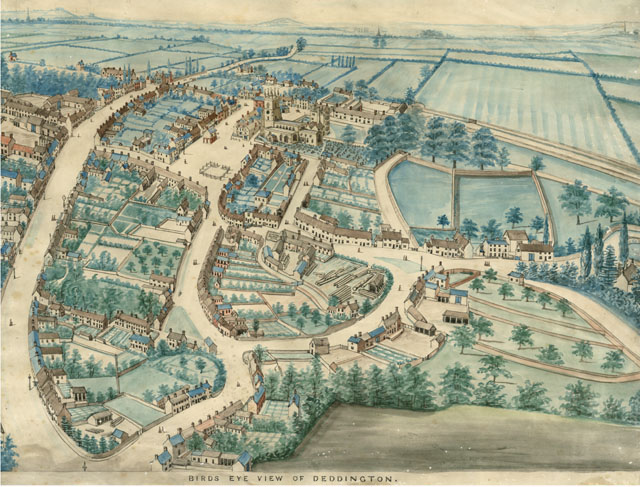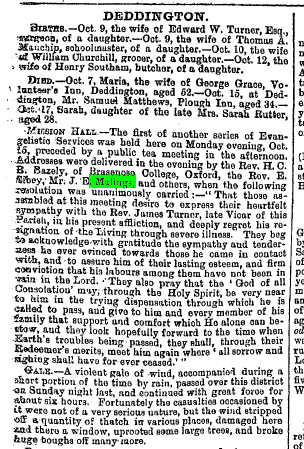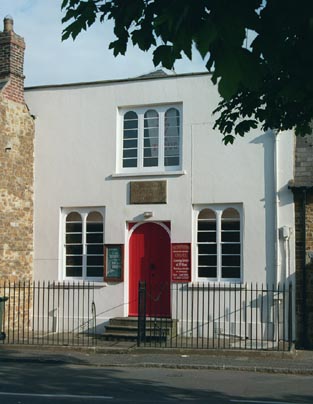Millennium Project
Former Methodist/Wesleyan Chapel in Church Street
This article brings together a variety of source information listed at the foot of the page. Amongst them I have to pay particular thanks to Jon Malings who is a descendant of the Joseph Malings who figures largely in the article. Jon's research on his family can be read elsewhere on this site and originally included reference (in the section on Joseph) to 'The Mission Hall' being sold by Joseph. Jon asked me which building this might be.This seemingly simple question took a lot of research to solve and has tuned up some very interesting facts along the way.
In the late 18th Century the Vicar (Rev John Faulkner 1790 -1822) is said to have built a 'Pavilion' at the foot of the garden of the Vicarage which runs behind the almshouses on Church Street. At some stage it was sold to the Methodist movement which was present in Deddington fom 1790. Pevsner's description: 'Wesleyan Chapel, Church Street of circa 1800: a miniature building like a garden pavilion, with key stoned sash windows and a gable with urn finials.' tends to support this.
It would seem that the building was being used as a school in the 1830s. Research by Buffy Heywood into the History of Deddington Schools indicates that the Rev Greaves (Vicar 1822 -36) started an Infant School in the building that subsequently became a Wesleyan Chapel.
Joseph Wilkin's Bird's-eye View of Deddington from the south (l) shows a fully eaved roof and accords with Pevsner's description. Colvin dates the drawing at 1875 but close observation shows that the church still has the Georgian porch which was demolished in 1863.
click on image to see the full drawing
|
There is some ambiguity as to whether the Church Street building was used for worship. Victoria County History says " For a time the Methodists also used the former public hall in Church Street as a Sunday school." but this press cutting (right) from Jackson's Oxford Journal in 1877 clearly refers to 'Evangelistic Services' being held in the Hall. There are several other report's in Jackson's throughout 1877/78 (follow this link) about various events taking place.; including a fund raising tea for the new Primitive Methodist Chapel in New Street at which ' a novel chicken which had two beaks and three eyes' was exhibited!
|
|
There is also reference in an Indenture dated 5th May 1879 to its use " as an Infants School and recently in part rebuilt and now used as a Reading Room or General Literary Institution..."
The Hall belonged to the Joseph Malings referred to in the report above. He was a Methodist, a preacher, a chemist and, somewhat controversially, an alternative medicine practicioner. He was also a churchwarden for a while. He was therefore quite a high profile person in the parish. More about Joseph and his farming family can be found by following this link.

He became even more controversial because, between 1876 and 1878, Joseph borrowed £200 from a Laura Proffit White, spinster of Shotteswell and £58 from a Harry Kilby, solicitor of Banbury - both with interest - on surety of the Hall. An Indenture of 14 May 1879 states that, as he has not repaid these loans, his debtors have caused him to sell the hall to the Trustees of the Wesleyan Reform Chapel. £147 of the proceeds goes to Laura and 10s.0d to Mr Kilby. This is an interesting story because Laura was only 21 when she made the first of two investments with the assistance of her solicitor and co-investor, Harry Kilby. More details about all of this can be found by following this link.
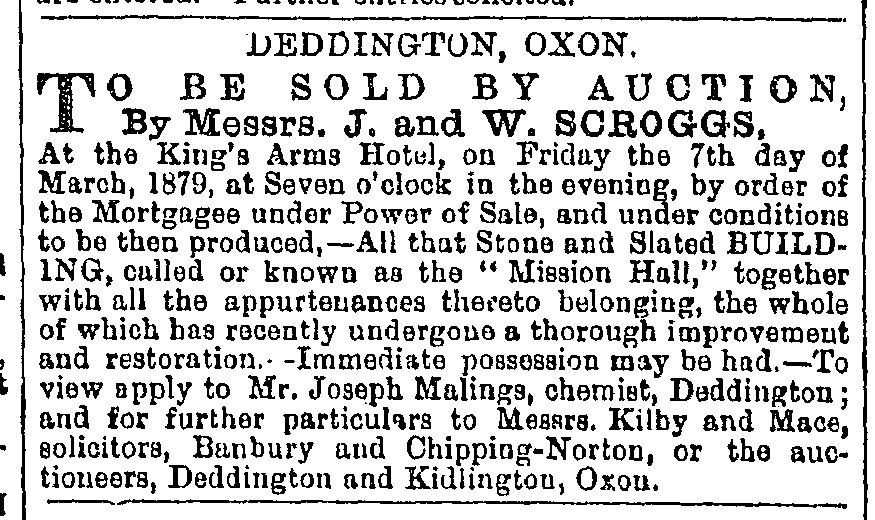
Of relevance to this unhappy story is the fact that the auction notice referred to the "thorough improvement and restoration" the Hall had recently undergone. James Hopcraft, a Deddington builder, is one of the eight named Trustees who purchase the Hall. Six of the other seven are also Deddington tradesmen. They would have been the people who did the improvement and restoration.
Joseph was obviously in serious financial trouble because a Journal report of April 1880 records that “A meeting of the creditors of Joseph Edward Malings, of Deddington, chemist and druggist, farmer, who has been adjudicated a bankrupt, was held at the office of the County Court, Oxford on Friday the 17th inst.” Joseph's liabilities were estimated at about £900 and his debtors included (inter alia) James W Hopcraft, brickmaker and builder and several others in the building trades. More information about quite who Laura White was and why she could afford some £10,000 in todays money, the circumstances of the loans,the Indenture deed and Joseph's bankruptcy can be found by following this link.
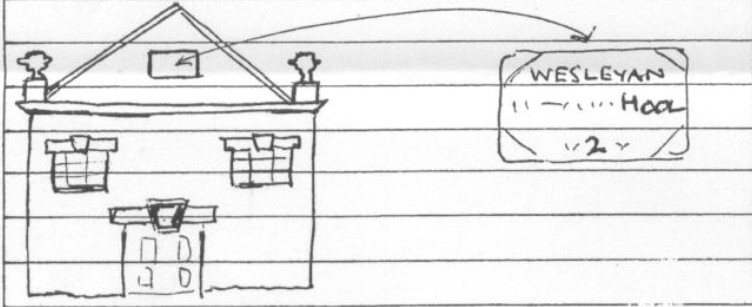 Buffy Heywood's article about Deddington Schools contains a photograph of the chapel; since it show a vertical front, it must be post the 'thorough improvement and restoration' of 1879,and probably before 1940, by which time, one would surmise, the elaborate iron railings would have been sacrificed for the War effort. The photo is a little blurred, but shows the finial vases in place and an indecipherable plaque above the door. We also have a sketch made by a historic building researcher in 1978 which confirms the photo and provides a bit of the wording on the plaque. "Note the high windows - to stop people peering in!- the finials referred to by Pevsner and the eaved roof at the front- which has now been replaced with a gable end."
Buffy Heywood's article about Deddington Schools contains a photograph of the chapel; since it show a vertical front, it must be post the 'thorough improvement and restoration' of 1879,and probably before 1940, by which time, one would surmise, the elaborate iron railings would have been sacrificed for the War effort. The photo is a little blurred, but shows the finial vases in place and an indecipherable plaque above the door. We also have a sketch made by a historic building researcher in 1978 which confirms the photo and provides a bit of the wording on the plaque. "Note the high windows - to stop people peering in!- the finials referred to by Pevsner and the eaved roof at the front- which has now been replaced with a gable end."
The other Wesleyan Chapel on Chapel Square
Victoria County History, in the section on Non-Conformity in Deddington refers to the other Methodist Chapel which can just be seen to the south of Pevsner's building ... "In 1800 a chapel was registered on the site of the surviving chapel in Chapel Square... The Chapel, a stuccoed building with Tudor style windows, seems to have been rebuilt in 1849" We know it was rebuilt because Deddington Methodists, who joined the Wesleyan Reform Movement opened it in 1851; as a plaque on the front of the building in the picture attests.
The Chapel closed for good in September 2018 and was subsequently sold to a locally owned company 'Auteur' which experienced great difficulty in establishing legal ownership but in December 2022 it finally opened for business and named the building 'Mission Hall' to acknowledge it's history
Sources:
- The Victoria County History for Deddington ,
- HE Colvin's History of Deddington (1963),
- Pevsner's Buildings of England, Oxford Records Office,
- Jon Malings
- Dr Donald Lane, former owner of the Mission Hall as a private dwelling
